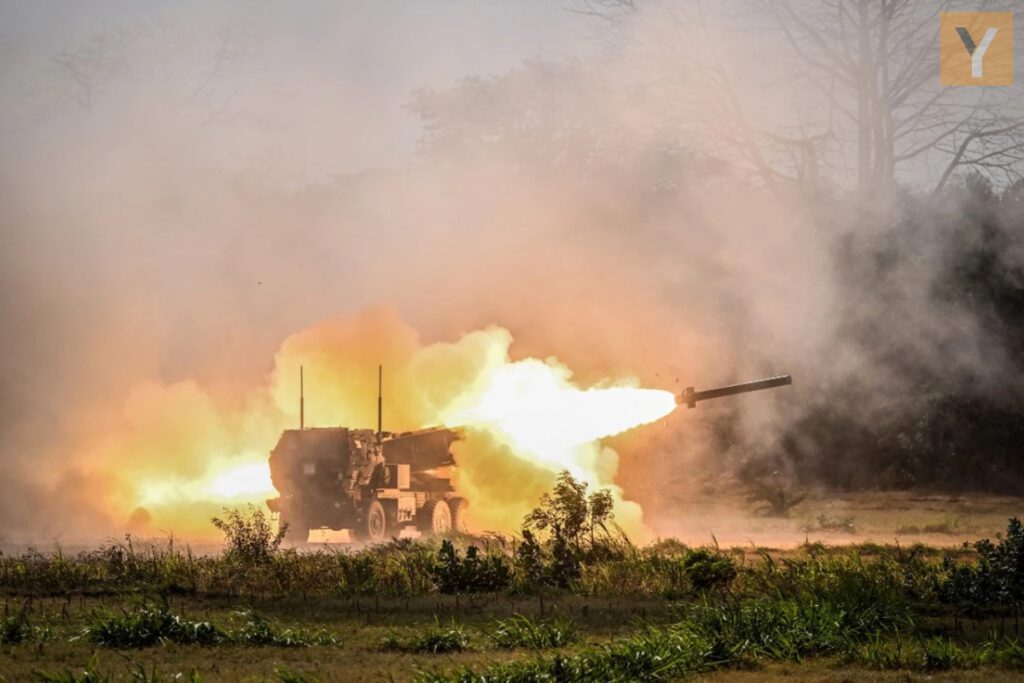
Recently, in a military operation in southern Ukraine, the Ukrainian Special Operations Forces (SSO) achieved a significant victory by utilizing an American-made HIMARS (High Mobility Artillery Rocket System) rocket launcher to neutralize a Russian Osa anti-aircraft missile complex. This successful engagement underscores the strategic importance of advanced military technology and the Ukrainian military’s capabilities in countering evolving threats.
Unmanned Aerial Reconnaissance
The operation commenced with the unmanned aircraft complex of the 73rd Maritime Center of the SSO conducting reconnaissance in the southern sector. Despite poor visibility, the crew of the unmanned aircraft complex identified a Russian Osa anti-aircraft missile system actively used against Ukrainian troops. The challenging conditions emphasized the precision and effectiveness of the Ukrainian reconnaissance efforts.
Swift action followed as the SSO aerial reconnaissance operators promptly communicated the discovered coordinates to the HIMARS operators. This seamless coordination between unmanned aerial reconnaissance and ground-based missile launchers was pivotal in the subsequent successful engagement.
Osa: An Overview of the Soviet Anti-Aircraft System
The Osa, a Soviet automated all-weather military anti-aircraft missile system, was designed to provide cover for motorized rifle (tank) divisions across various combat operations. Its development, initiated in 1960, aimed to create the first self-sufficient mobile air defence system in the Soviet Union. The Osa was officially inducted into service in 1971, with continuous modernization efforts.
The Osa-AKM variant, equipped with six 9M33M3 anti-aircraft guided missiles, is a formidable defence system. Each missile weighs 128 kg and carries a 15-kg warhead. With a 1.5-10 km range and the capability to engage targets at altitudes ranging from 10 to 5000 meters, the Osa-AKM boasts a 50 to 85 per cent probability of hitting a fighter-type target with a single missile.
Economic and Strategic Considerations
Analysts have highlighted the economic advantage of the Osa anti-aircraft system compared to its counterparts. The estimated cost of one Osa missile is $56,000, significantly lower than the $400,000 cost of a rocket for the modern German IRIS-T anti-aircraft system. This cost disparity raises questions about the efficiency and cost-effectiveness of different anti-aircraft missile systems in contemporary military landscapes.
[adinserter name="One"]The successful neutralization of the Russian Osa anti-aircraft system showcases the effectiveness of the HIMARS rocket launcher. It highlights the strategic importance of countering specific threats with precision. As military conflicts evolve, armed forces’ adaptability and ability to employ advanced technology become crucial for maintaining a defensive edge.
[adinserter name="Two"]Strategic Successes and Previous Instances
This recent success follows a pattern of strategic victories for the Ukrainian military. In January, Ukrainian forces destroyed a Solntsepyok (Blazing Sun) heavy flamethrower in southern Ukraine. With estimated costs ranging from $6.5 million to $15 million, the system drew attention for its effectiveness in generating high-temperature fireballs after strikes, making hiding in dugouts impossible.
[adinserter name="Three"]The Ukrainian military’s targeted approach towards specific Russian military systems, including the Solntsepyok and now the Osa, raises questions about the vulnerabilities and challenges faced by Russian military technology. While the Ukrainian military claims responsibility for these successes, the Kremlin remains tight-lipped about the losses, creating an air of mystery around the engagements.
[adinserter name="Four"]Conclusion
The successful deployment of the HIMARS rocket launcher to neutralize the Russian Osa anti-aircraft system marks a paradigm shift in military tactics. The integration of advanced technology, precise reconnaissance, and strategic decision-making demonstrates the evolving nature of modern warfare. As geopolitical tensions persist, the ability of armed forces to adapt and utilize cutting-edge technology becomes increasingly critical for ensuring national security and defence. The Ukrainian military’s recent achievements underscore their commitment to staying ahead in the dynamic landscape of military technology.
[adinserter name="Five"]Frequently Asked Questions (FAQs)
-
What is the significance of using an American-made HIMARS rocket launcher in the recent operation in southern Ukraine?
The use of the HIMARS rocket launcher holds strategic importance due to its precision and effectiveness in neutralizing the Russian Osa anti-aircraft system. The successful engagement showcases the adaptability of the Ukrainian military to employ advanced technology in countering specific threats.
-
How does the cost disparity between the Osa anti-aircraft system and its counterparts impact military considerations?
Analysts have noted a significant cost advantage with the Osa anti-aircraft system, with one missile costing $56,000 compared to the $400,000 cost of a missile for the modern German IRIS-T system. This economic factor raises questions about the efficiency and cost-effectiveness of different anti-aircraft missile systems in contemporary military landscapes.
-
What are the broader implications of the Ukrainian military’s targeted approach to specific Russian military systems, such as the Solntsepyok and the Osa?
The Ukrainian military’s success in targeting specific Russian military systems suggests a strategic understanding of vulnerabilities and challenges in Russian military technology. The engagements raise questions about the adaptability of Russian defenses and the evolving nature of military tactics, emphasizing the need for armed forces to stay ahead in the dynamic landscape of modern warfare.






